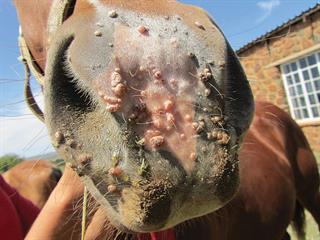
Warts are commonly seen in young horses after weaning and up to three years of age. They are small, irregular growths, pink or greyish in colour, and may be flat or oval. Warts can be between 1mm and 5mm in diameter, mainly on the muzzle, but also on the eyelids, chin, ears and in the genital area.
Although unsightly, they usually disappear after three to six months and are generally not regarded as a very serious “problem” in horses.
Causes of warts
The warts are caused by the equine papilloma virus, which is part of the Papillomaviridae family. It’s also related to the bovine papilloma virus, which causes warts in cattle and sarcoids in horses. Sarcoids are much larger than warts and commonly occur on the neck, flanks or legs. They’re very difficult to treat and can get very big.
They often reoccur after surgical removal. Equine papilloma warts are generally caused by a reduction in immunity often seen in young horses following the stress of weaning, change in food, or high worm burdens. The equine papilloma virus is highly infectious and affected horses should be isolated. The stables, food buckets and water containers should be cleaned and disinfected.
This is another reason why horses shouldn’t share water buckets, particularly at shows. Disinfectants should contain iodine, chlorhexidine or Virkon, and should be used to rinse water and feed buckets after cleaning. It’s advisable to wipe down the stable doorframes horses commonly rub their muzzles against. The incubation period is about two to three months, so it’s often difficult to identify the source. Horses eventually become immune.
Management and treatment
Facial warts are a disaster for breeders planning to show promising young stock at major shows. Not only are the warts unsightly, they are highly infectious, so an infected horse can’t participate in a show. The first step is to improve the horse’s immunity by deworming and ensuring that the feed has sufficient protein for growth (the warts often appear during a “growth spurt”).
Chronic low-level infection with biliary (Ehrlichia equi) can also reduce immunity. Your vet can check for this. Vets can also crush or cauterise the warts, allowing particles of the virus-infected tissue to come into contact with the bloodstream – in effect a self-inoculation of vaccine. Don’t do this yourself without a tranquiliser as it can make your horse permanently head shy.
Immune boosters such as lysine and brewer’s yeast can be added to the feed to shorten the period of infection considerably. It’s claimed that adding a heaped tablespoon of each to the feed twice a day can make the warts disappear within three weeks.
Both powders are very affordable and available at tack stores throughout South Africa. A herbal remedy suggested on the internet is olive-oil infused with fresh garlic and tea tree oil. The mixture is rubbed into the warts twice a day using rubber gloves.













